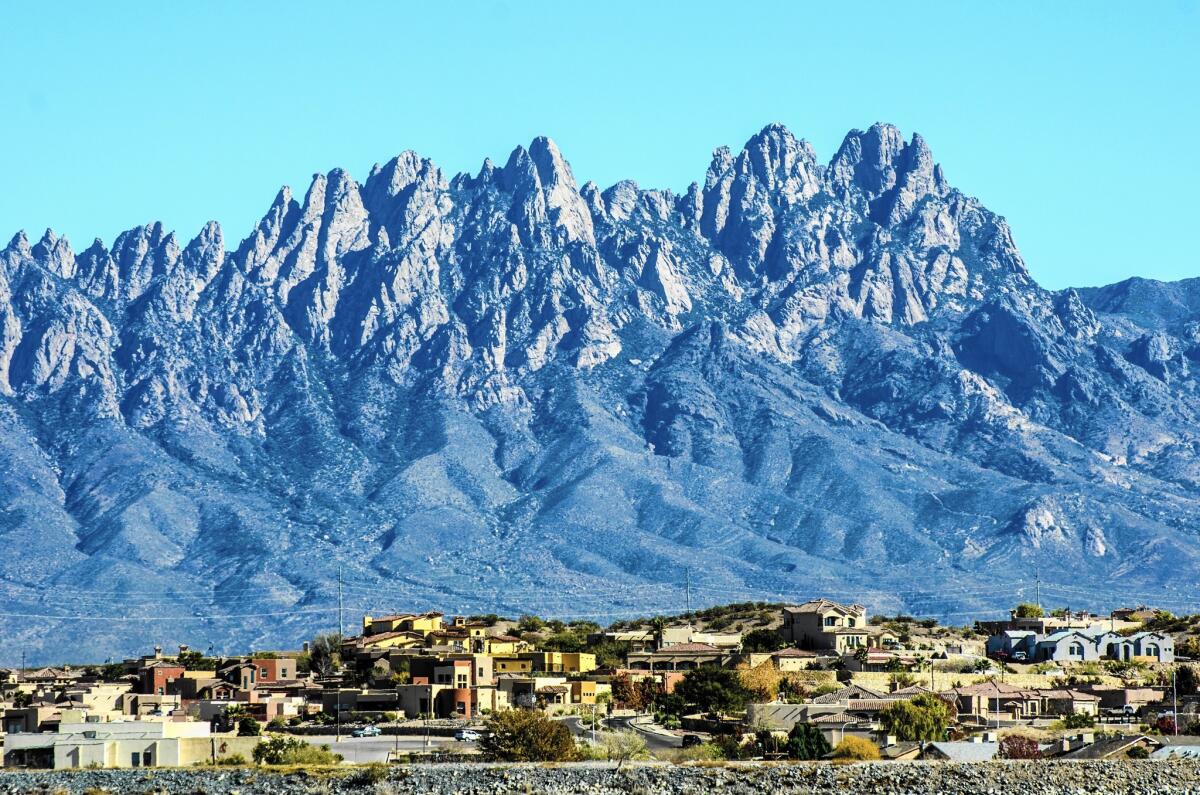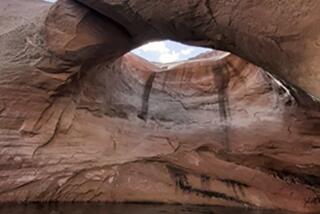Walk in the footsteps of Billy the Kid and Apollo astronauts at this national monument in New Mexico

As you drive through this crossroads of the Southwest, it’s difficult not to notice the sawtooth-ridged mountains bracketing the city to the east.
Known as the Organ Mountains, these rhyolite and andesite peaks emboss New Mexico’s southern basin and range area. The mountains love to show off in the evening, reflecting the orange hues of the setting sun.
See more of Travel’s top stories on Facebook >>
The Organ peaks, along with other nearby mountains and points of interest, are part of one of the United States’ newest national monuments. President Obama signed a proclamation creating the Organ Mountains-Desert Peaks National Monument in 2014, meaning nearly 500,000 acres of mountains, grasslands, volcanic craters and historic sites are preserved for public use.
I found one of the best things about the monument to be its accessibility. It’s split into four sections, all of them just a few miles from Las Cruces.
Although the monument’s offerings may not be world-class soaring sequoias or frothing geysers, it has gems beckoning for a visit, especially considering they’re not far out of a traveler’s way.
“So many people drive through this landscape, and they think it’s a wasteland. It takes a jeweler’s eye to look at it. In winter, birds from Canada are nesting here. It’s an unfragmented, wild landscape. That’s what makes it worth protecting,” said Jennifer Montoya, acting manager of the monument. Species found nowhere else, such as the Organ Mountain evening primrose, call the place home.
The range got its name because some observers thought the “needle” peaks atop the mountains resembled a church organ. I thought they looked more like the spinal plates of a gargantuan stegosaurus that had settled down for a permanent nap.
Either way, they’ve been described as the Grand Tetons of New Mexico because of their resemblance to the better-known formation hundreds of miles to the north.
Though the monument encompasses other neighboring mountain ranges too, the Organs contain some of its crown jewels. Dripping Springs stands as one of the must-see spots.
It’s a moderately easy trek, just a couple miles from the visitors center through grasslands dotted with oak and other trees to the springs, which do seem to drip out of a rock in the drier parts of the year. The Chihuahuan Desert mountains seemed to melt away during the slow, steady climb to the springs, with dry grass and occasional cactus giving way to lush shrubbery and chokecherries filled with wildlife.
A small, primitive dam built decades ago holds the springs’ offerings and was used as a source of water for a small 16-room resort that once operated in a nearby canyon.
It’s worth an extra half-mile of walking to see the crumbling adobe and stone ruins of Van Patten Mountain Camp, named for Eugene Van Patten, a former Confederate officer who founded it in the late 1800s. It went bankrupt within a couple decades, leading to its current state.
The hike to Dripping Springs, like others in the monument, is best done in the morning, because long stretches of the trail are exposed to the desert sun. But the morning jaunt also makes a perfect excuse to have lunch at the nearby La Cueva Picnic Area.
Named for a small cave just a couple hundred yards away, the picnic grounds sit on a slight hillside. The picnic sites have shelters with ample shade and space, and are oriented to provide eye-catching views of the Organ Mountains.
The Dripping Springs visitors center and the picnic area are 10 miles east of Interstate 25 along a paved road with two miles of graded gravel at the end. A $5 day-use fee covers both areas.
The Bureau of Land Management plans to augment recreational development at the monument over several years. To do that, the BLM will introduce guided hikes as well as adding interpretive signs to several areas, including those visited by famous outlaw Billy the Kid. Kilbourne Hole, an extinct volcanic crater south of Las Cruces used for lunar training by Apollo mission astronauts, will get similar treatment.
BLM officials could close roads in some areas of the monument, but most existing roads should remain open to the public. Mountain bikers will still be able to ride on popular routes in the Organ Mountains, as well as the Doña Anas and other nearby ranges in the monument.
Winter can be cool, but clear skies are common and most mountain biking and hiking trails throughout the monument remain open, said Montoya, who added that visitors should check conditions before heading out.
The Baylor Pass trail, easily accessible east of Las Cruces, is a popular route for day hikers and backpackers over the crest of the Organ Mountains. The five-mile trek ends at the Aguirre Spring Campground, also run by the BLM. The site is in demand as a respite from the summer heat, but it’s not so high that it freezes visitors in fall or winter.
Across the Mesilla Valley, Picacho Peak is not as picturesque as the Organ Mountains, but it compensates with other virtues. The rhyolite mound, its barrenness occasionally broken by flowering cactuses or Indian paintbrush, surveys the western end of town. Still, a rugged 11/2 -mile trail to the top rewards those possessing strong ankles with a panoramic view of Las Cruces, two states and northern Mexico, as well as the past and present.
To the east, the Camino Real (yes, New Mexico has one too) north toward Santa Fe parallels its modern incarnation, I-25. Just below, through narrow spaces between hills and across deep, sandy washes, once passed the Butterfield Overland stagecoaches carrying the mail to Los Angeles and San Francisco. From atop Picacho, I saw how closely development in western Las Cruces crept toward the peak and the former mail trail, sites now protected for future generations.
::
If you go
The best way Las Cruces, N.M.
From LAX, Southwest and American offer both nonstop and direct (stop, no change of plane) service to El Paso, Texas; and United, American and Southwest offer connecting service (change of planes). Restricted round-trip fares from $214, including taxes and fees. El Paso International Airport is the largest commercial airfield near Organ Mountains-Desert Peaks National Monument, about an hour’s drive on Interstate 10 to central Las Cruces. Ten car rental companies have counters near the baggage claim area. By car, Las Cruces is about 760 miles east of Los Angeles, roughly an 11-hour drive without stops.
WHERE TO STAY
Hotel Encanto de Las Cruces, 705 S. Telshor Blvd., Las Cruces; (575) 522-4300, www.hotelencanto.com. Almost garish New World Spanish and Southwestern décor, as well as its abundant customer service, sets it apart from the cookie-cutter offerings of most lodgings. Doubles from $94.
Josefina’s Old Gate, 2261 Calle de Guadalupe, Mesilla, N.M.; (575) 525-2620, www.josefinasoldgate.com. Three-room bed-and-breakfast and café in Mesilla, technically a separate town, but essentially a historic part of Las Cruces dating to Spanish colonial times. Suites from $200.
Staybridge Suites Las Cruces, 2651 Northrise Drive, Las Cruces; (575) 521-7999, lascruces-hotel.com. The chain hotel features suites starting at $108.
WHERE TO EAT
La Nueva Casita Cafe, 195 N. Mesquite St., Las Cruces; (575) 523-5434, www.lanuevacasitacafe.com. Mexican food served New Mexican style, such as enchiladas “Christmas style,” slathered in red and green chile. Save room for dessert and try the sopaipillas, a classic New Mexican puffed pastry, usually garnished with honey.
¡Ándele! Restaurante, 1950 Calle del Norte Suites 1-3, Mesilla, N.M.; (575) 526-9631. Mexican favorites with a few New Mexican dishes, such as a bowl of red chile.
Ardovino’s Desert Crossing, 1 Ardovino Drive., Sunland Park, N.M.; (575) 589-0653, www.ardovinos.com. This restaurant, around since 1949, sits almost atop the border about a half-hour south of Las Cruces. Skews Italian, with New Mexican twists such as green chile on its pizza.
TO LEARN MORE
Bureau of Land Management district office, 1800 Marquess St., Las Cruces; (575) 525-4300, www.blm.gov/nm/omdp.
Las Cruces Convention & Visitors Bureau, 211 N. Water St., Las Cruces; (575) 541-2444, visitlascruces.com.
More to Read
Sign up for The Wild
We’ll help you find the best places to hike, bike and run, as well as the perfect silent spots for meditation and yoga.
You may occasionally receive promotional content from the Los Angeles Times.






